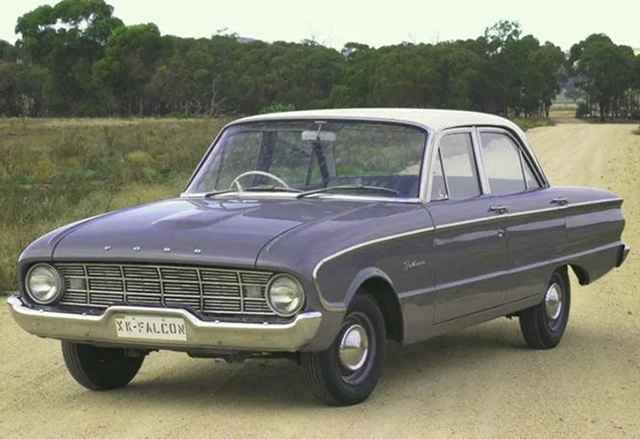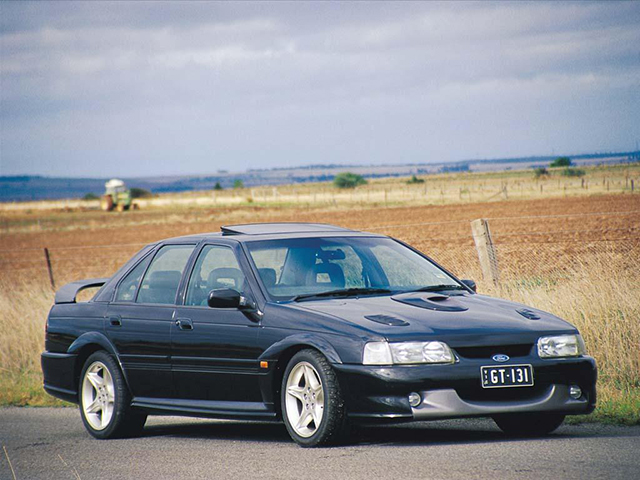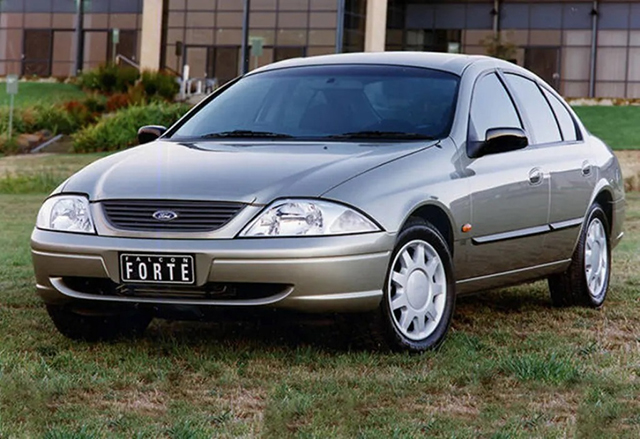The Blue Oval is, worldwide, one of the planet’s oldest automotive brands. We know that the production line method of vehicle assembly comes from Henry Ford’s idea, and that it’s the brand that gave “us” the ute.
Here in Australia there have been a number of cars locally developed and made that have influenced our market. To get an idea of how Ford has influenced Australia, we spoke to Rare Spares ambassador and a lover of all good things automotive, John Bowe who says:
“I am seen as a Ford person of course and I’ve taken a bit of flack over the years, but in reality I am a “Car Person” “says John. I love all cars that are worthy , that's why I'm racing a Holden Torana A9X now in the Paynter Dixon Touring Car Masters which you would all know has been postponed by The shocking Covid 19 pandemic ! I've been asked my top 5 influential Ford Australia products.

John’s first pick echoes our first for the Holdens. John went for the 1960 XK Falcon because it was the first Australian Falcon. As JB says: “I know it wasn't a great car but it started our Ford local legendary Falcons.
The XK was, in essence, an Australianised version of the Falcon then available in the U.S., with a few modifications for rural markets such as larger wheels and an extra leaf in the rear suspension.

Power came from a 144ci straight six and a 170ci straight six, with 67kW and 75kW. Rear wheel driven, the transmissions were a three speed column shift manual or two speed “Ford-O-Matic” auto.
John’s number 2 choice showed just how quickly Ford Australia had moved in its design and engineering. 1966 and the squared off XR Falcon was released. The 170ci had been carried over and was actually the entry level engine available.
Why the XR stands out for John is on a two-fold level. There were a staggering nine variants available, with the Falcon, Falcon 500 (which replaced the “Deluxe” nameplate used in the preceding XP), and the Fairmont nameplate, across a sedan, wagon, and utility vehicle body shape. A 200ci straight six, an engine that would form the basis for Falcon engines for a couple of decades to come, was introduced.

However, it was the Mustang-derived 289ci V8, available as an option for the first time in an Australian made vehicle across all variants, that sets the XR apart here. Ford traded off the Mustang relationship heavily, and in 1967 the Australian motoring landscape was forever changed with the introduction of the first GT and the beginning of the Australian muscle car era.
168kW came from the 289ci V8 and buyers could choose from GT Gold or GT Gold for the exterior. Ford, though, managed to quietly sneak in eight clad in Gallaher Silver, and five with their own individual colours of Russet Bronze, Sultan Maroon, Polar White, Avis White and Ivy Green. It’s not known what has happened to these rarest of the rare GTs.
John is definite in declaring that GT, one of his boyhood dream cars, was a big deal for the Aussie market, as these cars were released before the HK Kingswood and Holden’s V8 Monaro. And as history records, the XR GT would go onto to win the Gallaher 500 at Bathurst in its debut year, and inspire the Phase 1,2, and 3 Falcons including the mighty XY GTHO Phase 3 and stillborn Phase 4 XAs.

Number 3 is a walk-up start in the influential stakes. GT is the name, EB Falcon was the donating game. At the time, says John, it was a massive commitment by a company that had deleted the V8 from its powerplant options a decade before.
The EB Falcon was available from 1991 to 1993 and was a mildly facelifted version of the Euro-influenced EA. The base engine was a 3.9L six, essentially an updated version of that 3.3L from the 1960s which had morphed into a 3.2L and 4.1L in the years between.
A mid-life update and a collaboration with specialists Tickford Vehicle Engineering saw Ford reintroduce the GT. The EB had been re-engineered to accept a V8 and a sports model, the XR8, had been incorporated into the range.
The GT took this a step further, and fitted with a more extensive bodykit, including what Dick Johnson called a “pie warmer” on the bonnet. 25 years after the first GT had been released, the EB GT packed 200kW, 420Nm, and would see a top whack of 230kph from a 0-100kph time of 15.3 seconds.
Although relatively subtle in styling as Ford Australia weren’t then sure how it would be received, this would change drastically for the next GT, the EL, a model JB worked with Tickford’s engineers in developing the drive and ride.
Slotting into the number four grid position is a pair of GTs and based on the BA Falcon platform. Ford Performance Vehicles had been given the job of developing a new competitor to HSV, and the BA range was the natural successor. The standard Barra V8 offered 220kW and due to the design, had Ford redesign the bonnet to provide a subtle bulge to fit the top of the engine.

The GT was powered by a Mustang related 5.4L V8. DOHC 4-valve cylinder heads from the Mustang Cobra R engine were fitted, and FPV named it the Boss 290 thanks to the 290kW output. Torque was a very handy 520Nm. Price? A then steep $59,810.
FPV also brought in a GT-P and Super Pursuit ute, based on the GT-P. Wheels were 19 inch alloys and Cobra-style striping pulled the optics to the solid looking BA body.
John was heavily involved in the development of the BA GT, spending thousands of driving kilometres behind the wheel. He reminds that the engines were hand assembled in Campbellfield and the suspension was a bespoke tune for the GT family. Ford’s Mark Behr understood the value of what the BA GTs represented and did a standout job in marketing these machines. The cars led to the GT range becoming a stand for Ford through to the last Falcon, the FG.
Number five and there shouldn’t be any surprises for the fact it’s the AU falcon. AU for Australia and falcon as the badging harkened back to the font used in the 1960s.
The AU was part of what Ford’s design studios called “Edge Styling” It was, it’s fair to say, an odd mix of those straight lines for the headlights and grille in the base model contrasting with the ovoid roofline, windows front and rear, and that tapered, drooping bootline that housed tail lights mirroring the headlights. Inside was a reflection of the exterior, with rounded shapes peppering the dash design.

John recalls being one of those invited by Ford to attend the AU’s launch and the muted response from those in attendance when the AU was rolled out for the first time.
However, it wasn’t all bad news as the XR range, specifically through to the Series 3 version, improved upon improvements, and would give subsequent XR variants the famous “cannon” headlights. There was the “biplane” rear wing early on as well for the XR8.
It wasn’t well received enough for Ford Au to stay with the AU branding and the redesign quickly addressed the visual shortcomings, leading to the BA and models beyond.
John signs off with a nod towards the Falcon’s “Holy Grail”package as developed by the former engineers of FPV, now called Premcar. These were engine and handling options that were made available for the FG and as John hints at, could have been “The best Falcon ever made by a long way.”
Says JB: “I miss the Falcon lots but in the car world nothing stays the same, does it....
Drive safely and enjoy the love of your cars!!”
Which Ford Australia product influenced you, which car from the Blue Oval’s stable has made its lifelong impact on your automotive history? Let us know your thoughts via our feedback section.